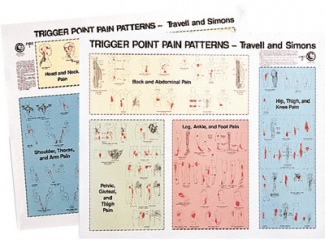

- #TRAVELL AND SIMONS TRIGGER PAIN POINT PATTERNS CHART MANUAL#
- #TRAVELL AND SIMONS TRIGGER PAIN POINT PATTERNS CHART PROFESSIONAL#
Nonetheless, taken at face value, the hypothesis for Myofascial Pain Syndrome (MPS) advanced by Travell and Simons seemed quite convincing: myofascial trigger points (MTrPs) were the sites of tissue damage, and resided within taut bands located in the culprit muscles. However, as they did not publish the evidence upon which they based their patterns, it appeared to me that the illustrations were based on little more than inspired guesswork. Could their theory of “myofascial pain” arising from “trigger points” fill the large gap in my understanding of these complex clinical problems? These authors expanded upon an earlier publication by Travell and Rinzler in which patterns of “pain referral” from specific muscles were illustrated.
#TRAVELL AND SIMONS TRIGGER PAIN POINT PATTERNS CHART MANUAL#
By chance I came upon the first edition of The Trigger Point Manual by Janet Travell and David Simons. I was forced to admit that my training and subsequent experience as a rheumatologist did not help me to understand the clinical phenomena associated with “RSI” that I encountered daily. At that time the Australian epidemic of repetitive strain injury (“RSI”) – a diagnosis applied to primarily upper limb (forearm and wrist) symptoms, the cause of which was attributed to keyboard and other occupational overuse – was raging.

I had a long-standing interest in what was then called Physical Medicine, and my most valued textbooks were those written by James Cyriax, Allen Stoddard and John Bourdillon. “The study of fallacies … should attune the student to the omnipresent dangers to which we are exposed as a consequence of imprecise expressions – vague, ambiguous, or misdefined terms – or of unarticulated assumptions and presuppositions. In anticipation, and with tongue almost completely in cheek – remember to avoid the ad hominem mistake and the straw man mistake. I expect it to stir some intriguing emotions in many of you and we welcome comments and alternative perspectives. We asked him to present their position in blog form. John Quintner and colleagues recently published a controversial review in Rheumatology. Over this holiday season we are posting the most read articles from the last five years. Travell and Simons methodically developed a working model based primarily on muscle anatomy and function, which evolved over years of observation and empirical testing. Travell looked to find myofascial constrictions at the root of each patient’s pain and dysfunction. National, Regional, and Global Pain Initiatives In developing her trigger point approach, Dr.Global Alliance of Partners for Pain Advocacy (GAPPA).Desirable Characteristics of National Pain Strategies.Access to Pain Management: Declaration of Montreal.IASP Position Statement on the Use of Cannabinoids to Treat Pain.Part 2 – “Long Hauler” COVID-19 Pain Morbidities & Their Management.Part 1 – Elevating Healthcare Professionals & Available Resources.First Steps: The Early Years of IASP 1973-1984.Guide to Pain Management in Low-Resource Settings.
#TRAVELL AND SIMONS TRIGGER PAIN POINT PATTERNS CHART PROFESSIONAL#


 0 kommentar(er)
0 kommentar(er)
